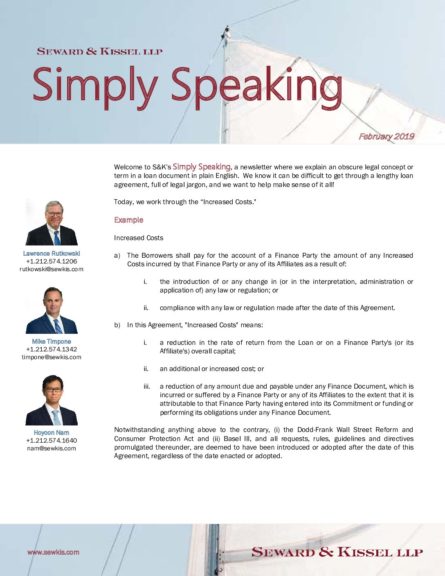
Simply Speaking (February 2019)
Welcome to S&K’s Simply Speaking, a newsletter where we explain an obscure legal concept or term in a loan document in plain English. We know it can be difficult to get through a lengthy loan agreement, full of legal jargon, and we want to help make sense of it all!
Today, we work through the “Increased Costs.”
Example
Increased Costs
- The Borrowers shall pay for the account of a Finance Party the amount of any Increased Costs incurred by that Finance Party or any of its Affiliates as a result of:
- the introduction of or any change in (or in the interpretation, administration or application of) any law or regulation; or
- compliance with any law or regulation made after the date of this Agreement.
- In this Agreement, “Increased Costs” means:
- a reduction in the rate of return from the Loan or on a Finance Party’s (or its Affiliate’s) overall capital;
- an additional or increased cost; or
- a reduction of any amount due and payable under any Finance Document, which is incurred or suffered by a Finance Party or any of its Affiliates to the extent that it is attributable to that Finance Party having entered into its Commitment or funding or performing its obligations under any Finance Document.
Notwithstanding anything above to the contrary, (i) the Dodd-Frank Wall Street Reform and Consumer Protection Act and (ii) Basel III, and all requests, rules, guidelines and directives promulgated thereunder, are deemed to have been introduced or adopted after the date of this Agreement, regardless of the date enacted or adopted.
What is it and what does it do?
The Increased Costs provision is a yield-protection and risk-allocation provision for the benefit of the lenders, putting borrowers on the hook for any additional costs that lenders incur or reduction in profits realized by the lenders during the term of a loan resulting from changes in law after the parties entered into the loan. The provision generally identifies (1) the specific costs borrowers are required to absorb (see clause (b) above) and (2) what constitutes a change in law requiring such reimbursement of costs (see clause (a) and the final paragraph above).
Why is it there?
When governments and global banking oversight organizations such as the Basel Committee on Banking Supervision impose new laws, rules and regulations (or change existing ones) impacting lending institutions, such as capital adequacy and liquidity requirements, lending institutions may, as a result of outstanding loans, face additional costs associated with compliance. The Increased Costs provision determines which party is required to absorb these costs.
Why is it important (or not so important) to Lender?
Lenders will almost always include an Increased Costs provision in a loan agreement to protect their anticipated return associated with the loan. The provision shifts the costs of complying with new laws to the borrower on the basis that such costs were not measurable when the loan was priced.
How does it affect Borrower in practical terms?
In practical terms, Increased Costs provisions are broad and highly subjective, and as such pose a risk to borrowers that is likely not clear until a claim is made. However, lenders are generally hesitant to make such claims unless a very significant change in law happens, such as Basel III or Dodd-Frank regulations.
How is it relevant to shipping?
The Increased Costs provisions are somewhat more robust for lenders making shipping loans because of the involvement of lending institutions in Europe, which are active in the ship lending space. European lenders have started to include in the Increased Cost provision references to Basel IV, which has not yet been finalized, but is expected to bring about even more extensive data requirements for monitoring exercises and quantitative impact studies for a wider group of lenders, and therefore increased lending costs.
How is it negotiated?
Both LSTA (Loan Syndications and Trading Association) in the US and LMA (Loan Market Association) in the UK have published sample clauses requiring borrowers to reimburse lenders for these increased costs arising during the term of a facility, and the concept itself is broadly accepted by the banking community. Some lenders try to put a time period by which such costs are required to be reimbursed (e.g. within 10 business days following the making of the claim).
Borrowers often try to negotiate for a certificate by the lender setting forth detailed calculations of the increased costs being claimed and to include a time restriction for retroactive claims by the lender of such costs (e.g. nine months prior to the notice of such claim).
In addition, the Increased Costs provisions are often qualified by the lender’s obligation to mitigate such costs by designating a different lending office or assigning its rights to another affiliate and may be subject to the borrower’s “yank-a-bank” right (i.e. the borrower may have the right to replace the lender).
It is generally accepted that the Dodd-Frank Wall Street Reform and Consumer Protection Act and Basel III are treated as a “change in law” despite being enacted in 2010. The rationale for these exceptions is that not all of the implementing rules under Dodd-Frank or Basel III have been finalized, and lenders cannot be certain of the impact these will have on their lending operations.
Questions?
Please contact any one of S&K’s Maritime Practice Team.
